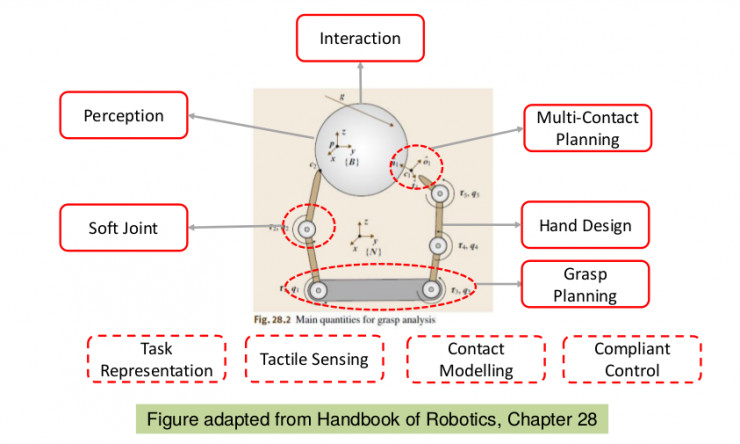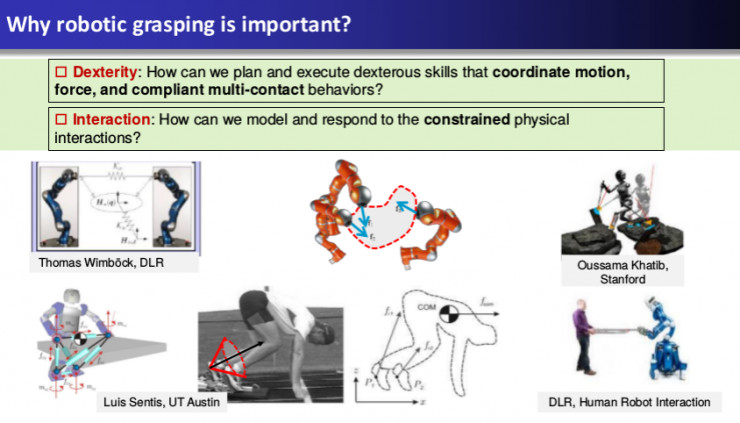1. What is robot crawling? As shown in the figure below, given an object and hand, the basic problem of robot crawling is divided into three: How to catch How to control How to operate According to the difficulty, these three questions are basically increasing in turn. 1. How to catch it? (Grasp Planning) This problem is basically a group of big cattle research issues from the beginning, including Salisbury, Mason, Cutkosky, Khatib and so on. Everyone studies and studies, just want to know: Given an object, given a task, given a hand, how should this hand grab the object is the best? The most famous result in this direction is force-closure, which is basically equivalent to the stability of control inside for a long time. Two years before I was a Ph.D., I basically did this. At that time, my post-doctor Sahar did a pretty good job in this direction, but she switched to finance. Recently, this direction is basically going to the road of combining with Learning. You can refer to Sergey Levine's work at Google. 2. How to control? (Grasp Control) The problem is to study force control, including force control at the end of the finger, tactile control, etc., stiffness control, impedance control, and so on. For a long time, everyone was trying to calculate what kind of finger grabbing power is the best (when I started to study for a master's degree in the same year, the first professor Imin Kao who mailed me a paper paper was the grasping stiffness control. of). It is most famous for the work of Martin Buss and Li Zexiang's teacher group. It transforms a nonlinear optimization problem into a linear matrix inequality problem, and the optimization result can be obtained in about tens of milliseconds. The best work in this area of ​​the past should be regarded as the object-level impedance control (IJRR) from DLR (the first author of the article Wimbock also changed). The main players who are still sticking in this direction are Japanese professors, including my collaborator Kenji. It is said that Kenji’s boss, Professor Arimoto, started to engage in robotic crawling after he retired, and he also published a book. He belongs to the ancient gods level, and few people know that IROS 2016 is also a high-end birthday party (2006 International Symposium on Advanced Robotics and Machine Intelligence). 3. How to operate? (Dexterous Manipulation) The dexterous manipulation of the last problem has not made any good progress for many years, and few people have touched it now. Cutkosky's doctoral thesis was to engage in this. Later, he worked for a few years, and then changed the name of the lab. It turned out to be the direction. The Peter Allen group used to have a postdoctoral fellow to do this. Later, it seems to be a dive. It is a pity. The recent soft robotics is on fire, and this direction seems to have a new turn. Oliver Broc is also starting this direction. Second, why is robotic grabbing important? As shown in the following figure, the research of robotic crawling involves many aspects, including mechanics, control, computer, artificial intelligence and so on. Many times, robotic grabbing is a good minimal example to support research in all directions. Secondly, the research content of robotic capture, especially dexterity and interactivity, can play a role in many other related research. The second picture below illustrates this point. In addition, crawling is also an essential function for robots to enter the real world. Hands are so important to humans, and we certainly want to give the robot the same function. 3.2V 50Ah Li-ion Prismatic Cell
Is The Battery Cell Important to The Lithium Battery Performance?
solar power system residential, lithium ion battery pack, lithium iron phosphate battery ShenZhen UFO Power Technology Co., Ltd. , https://www.ufobattery.com


The devil is in the detail. Before assembly, each lithium battery cell has gone through a rigorous inspection before use. We are dedicated to bringing confidence to our customers when using our battery cells.
Product Safety Test
> Thermal exposure test
> Short-circuit Test
>Over charge & Over discharge Test
> Free-drop Test
> Crush & Squeeze Test
> Temperature Test
> Low Pressure Test